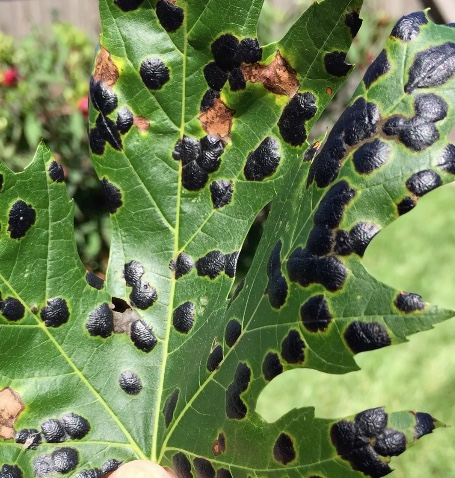Banner image: tar spot on maple leaf, photo by Purdue Plant and Pest Diagnostic Laboratory
Maple trees are among the most loved and widely planted shade trees in home landscapes. Maples produce seeds that fall like tiny helicopters from the tree, which kids love to run to and catch. As popular as these trees are, people become alarmed about this time of year when the leaves on some of these maple trees have large black spots that look like they’ve been splattered with tar.
Ironically enough, this disease is aptly named, “Tar Spot.”
Gail Ruhl and Tom Cresswell, from Purdue Plant and Pest Diagnostic Laboratory, co-authored an article on tar spot.
“Tar spots on maples are caused by fungi in the genus Rhytisma,” they said. “Genus” is the name for a family or grouping of similar organisms, in this case, tar spot diseases. Within a genus there may be several species. When speaking of several species within the same genus, usually the genus is abbreviated, in this case to R.
“The most common species are Rhytisma acerinum and R. punctatum,” they said. “Symptoms first appear in late spring or early summer as infected leaves develop light green or yellow-green spots.” They said that during mid- to late-summer these produce black tar-like raised structures on the upper surface of leaves within the yellow spots (see Figure 1). “R. acerinum causes larger spots that are 0.5 to 2 cm in diameter; R.punctatum causes many small punctate spots that are smaller (about 1mm in diameter),” they said. “Spots caused by R. punctatum are sometimes called speckled tar spots.”

Figure 1: Tar spot on maple, photo by Purdue Plant and Pest Diagnostic Laboratory
To get a more concrete idea of what these spots look like, they are typically about the size of a little smaller than a dime to about the size of a nickel, and jet black. The speckled tar spot cluster is about the same size, but with tiny jet-black spots within the cluster. Spots may grow and eventually coalesce to yield a larger black mass up to 1½ inches in diameter (see Figure 2). The fungus may also attack the seeds of maple.

Figure 2: Tar spot on maple - spots may coalesce over time to form larger spots, photo by Purdue Plant and Pest Diagnostic Laboratory
Most of our maples in Indiana are susceptible, including sugar, red, Norway and silver maples.
Many of the homeowners I have interacted with in the local Purdue Extension office are simply alarmed at the striking appearance of the large, black spots on their maple leaves, and they wonder if the disease will kill their trees. Although tar spot disease may cause premature defoliation, seldom are they detrimental to the overall health of infected trees.
“The good news is that tar spot causes little stress for the trees that are infected, despite some loss of leaf function and occasional premature defoliation,” they said.
At this point in the year, through photosynthesis, the leaves have nearly completed their annual job of manufacturing carbohydrates for the tree for maintenance and growth. That is why many late-season leaf spots, like tar spot, are usually inconsequential to overall tree health.
Ruhl and Cresswell said that fungicides are not recommended for this problem. “Tar spot can even be reduced for the next year by raking, chopping, and composting fallen leaves or removing leaves from the property since the fungi overwinter on leaves,” they said.
Find Ruhl and Cresswell’s original article at: https://www.purduelandscapereport.org/article/tar-spot-on-maple/.